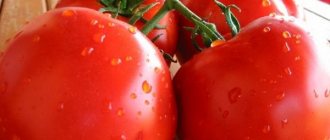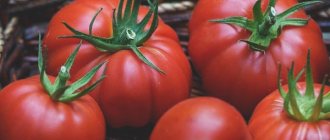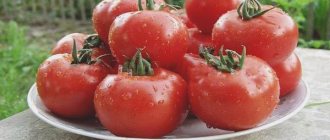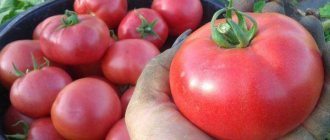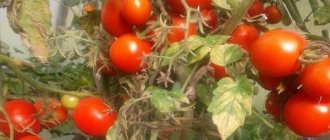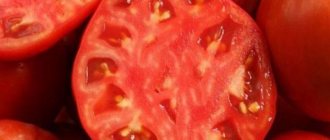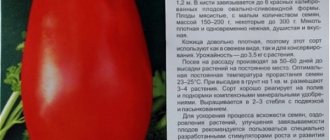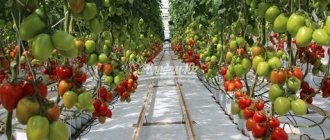| Ripening period: | 90-105 days, (early ripening) |
| Shape, weight of fruits: | round, 130-200 g |
| Bush height: | up to 1.3 m |
| Productivity: | 14-19 kg per 1 m² |
| Growing regions: | southern, with a warm climate (+18 - +25 degrees). In the northern regions it is grown in greenhouses |
Tomato Fidelity F1 is distinguished by excellent taste, large size, early ripeness, and high yield. The variety belongs to the determinant type. Despite its short stature, it requires a mandatory garter. Tomatoes are suitable for canning, making tomato juice, and pickles. An important advantage of the Vernost variety is its unpretentiousness when grown.
Description and characteristics of the variety
The height of the Vernost tomato bush is 1.3 m. The plant with powerful stems and rhizomes has dark green smooth leaves and white flowers. The shape of the inflorescences resembles bunches of grapes with large fruits weighing 130-200 g. Tomatoes have a round shape with flattened “poles”.
The early-ripening hybrid is characterized by good transportability, which is ensured by the dense skin of tomatoes, which is resistant to cracking.
The fruits have a rich red color and a sweetish taste. Their interior is divided into several chambers, each of which consists of dense, fleshy and juicy pulp.
Under favorable conditions and following the correct growing technology, up to 19 kg of tomatoes per season can be harvested from 1 m².
From the moment the first shoots appear until the fruits fully ripen, 90-105 days pass.
The culture is intended for cultivation in open or closed ground. It is light-loving and grows poorly in shaded areas.
Tomatoes Vernost F1 are not picky about the quality and composition of the soil and can grow well in poor, heavy soils.
Tomatoes “Volgogradsky Skorospely 323”: description of the variety
| Variety name | Volgograd early ripening 323 |
| general description | Early ripening determinate variety of tomatoes for growing in open ground and greenhouses |
| Originator | Russia |
| Ripening period | 110 days |
| Form | Fruits are round, flattened, slightly ribbed |
| Color | The color of ripe fruits is red-orange |
| Average weight of tomatoes | 80 grams |
| Application | Universal |
| Productivity of the variety | up to 8 kg per sq.m |
| Features of cultivation | Standard agricultural technology |
| Disease resistance | Resistant to most diseases |
The plant is determinate (does not require removal of the top to stop growth), and is not a standard bush type. The stem is persistent, thick, grows only up to 45 cm, on average up to 30 cm, has a lot of foliage and clusters with fruits. The rhizome, despite its small growth, is well developed in breadth, without any depression.
The leaves are medium-sized, typical “tomato”, light green in color, have a wrinkled structure, without pubescence. The inflorescence is simple, contains up to 6 fruits, of intermediate type. The first inflorescence is formed above the 6th - 7th leaf, then comes with an interval of 1 leaf, sometimes without intervals. Pedicel with articulation.
According to the degree of ripening, the Volgograd tomato variety is early; the harvest ripens 110 days after most seedlings emerge. The variety has good immunity to major diseases and does not suffer from late blight.
“Volgograd early ripening 323” was created for cultivation in open ground; it also grows well in greenhouses. Doesn't require much space. The shape is round, flattened at the top and bottom, with few ribs. The color of unripe fruits is light green, then they turn yellow; ripe fruits are red with an orange tint. Size - about 7 cm in diameter, weight - from 80 g. The skin is smooth, shiny, thin, and has good density.
The pulp is juicy, fleshy, dense. Dry matter content is slightly more than 6%. A large number of seeds are distributed evenly across 5 to 7 chambers. It can be stored for a long time if the necessary conditions are met.
Important! The harvested crop is stored in a dark place with minimal humidity. Transportation goes well, the fruits do not wrinkle or crack. You can compare the weight of the fruits with other varieties in the table below:
You can compare the weight of fruits with other varieties in the table below:
| Variety name | Fruit weight |
| Volgograd early ripening | from 80 grams |
| Raspberry Viscount | 300-450 grams |
| Kate | 120-130 grams |
| The Tsar Bell | up to 800 grams |
| Crystal | 30-140 grams |
| Red Arrow | 70-130 grams |
| Fatima | 300-400 grams |
| Verlioka | 80-100 grams |
| Explosion | 120-260 grams |
| Caspar | 80-120 grams |
Sowing seeds and growing
Seeds are planted for seedlings in mid-March - early April. It is not recommended to sow earlier than the specified dates for several reasons:
- Daylight hours are shorter in February. Due to lack of light, seedlings will begin to
stretch out, become pale and thin. As a result, after planting in open ground, the plants will need time to gain strength and acquire a normal shape. As a result, the fruits of such seedlings may ripen later than when planted in the second half of March. You shouldn’t keep a lamp on around the clock over your tomatoes, trying to extend daylight hours - some important biological processes can only take place in the dark.
- The optimal age for planting tomato seedlings in the ground is 50-60 days after emergence. Seeds sown during the recommended period will grow by mid-May - early June. It is at this time that the weather is favorable for planting seedlings. Plants sown a month earlier than the optimal time will have outgrown by the time they move to the garden bed, which will negatively affect their health, quality and quantity of ovaries.
Many gardeners plant tomatoes ahead of schedule, along with peppers, believing that this will allow them to get an earlier harvest and save time on sowing different crops. But in fact, there are no agrotechnical justifications for earlier sowing of tomato seeds.
Sowing tomato seeds Fidelity F1 for seedlings is carried out in the following order:
- The seeds are sorted, discarding small and deformed specimens.
- Planting material is treated in a 1% manganese solution, keeping it for 20 minutes. This procedure is carried out for the purpose of disinfection and prevention of disease development. You can also use 2-3% hydrogen peroxide, heated to a temperature of 40-45 degrees. Exposure time - 7-8 minutes.
- It is recommended to soak tomato seeds in a special nutrient solution before planting. You can use homemade products (aloe juice, potato juice), or store-bought drugs (Immunocytophyte, Potassium Humate, Sodium Humate, Epin, Virtan-Micro).
Sorted and processed seeds are sown in special boxes, which are installed on well-lit window sills. When planting plants in large quantities, seeds are sown in greenhouse beds.
Picking of young seedlings is carried out after the formation of 1-2 full-fledged leaves.
Description of the Werner tomato variety, its characteristics and yield
Hybrid tomato Werner was bred by Dutch breeders. It is suitable for open ground. But it is also successfully grown in film greenhouses. This is an early ripening beef tomato. It bears fruit well even in northern regions.
Characteristic
This hybrid type of tomato has an optimal combination of plant power with early ripening and the formation of relatively large fruits. The height of the bushes is no more than 70 cm (a determinate type of tomato), they have little foliage.
Tomato ripening occurs approximately 90 days after the appearance of the first shoots. The weight of one Werner tomato can reach 240–280 g, and in some cases - 300 g. Weather conditions have only a slight negative impact on the quantity and quality of the ovary formed.
The fruits have a rich pink color, and the taste is quite high. On a 10-point scale, this hybrid has 9 points. They do not contain the usual acid inherent in many representatives of this type of vegetable. The sugar structure of the fruit is most organically suitable for eating Werner tomatoes fresh, for adding to salads, as well as for making juices, pastes or ketchup.
Tomatoes have a flat-round shape. On top they are covered with a rather dense skin. This circumstance prevents it from cracking under unfavorable irrigation conditions (insufficient or too abundant irrigation). As reviews note, the plant is highly resistant to disease.
Landing rules
Tomato seeds are sown in containers for growing seedlings no earlier than March. Before sowing, seeds must be treated with special means and then disinfected. For this purpose, a weak solution of manganese is used. The seeds are dipped in a slightly warm liquid for a quarter of an hour, and then placed in a solution of Epin for 12 hours, having previously studied its description. Seeds prepared in this way are planted in containers with soil.
Planting in the ground and caring for tomatoes
When the seedlings grow up and a stable warm temperature is established outside, Vernost tomatoes are planted in open ground.
It is first recommended to harden off young plants that grew on a windowsill or in a greenhouse. To do this, boxes with seedlings are taken outside during the week before planting.
The first day they are left in the fresh air for 20-30 minutes, and in subsequent days the hardening time is gradually increased. This procedure must be carried out to increase the resistance of plants to low temperatures, which often occur in spring.
Although the Vernost variety is not picky about soil quality, it is still recommended to plant tomatoes in slightly acidic or neutral soil fertilized with humus. This will allow you to grow strong, healthy bushes and get a good harvest.
The distance between rows should be 70 cm, between bushes - 40. Seedlings are planted in a checkerboard pattern, two seedlings in one hole and immediately filled with plenty of water.
When planting more than 400-500 bushes, it is advisable to make trenches along the entire length of the row rather than holes around each plant. This will save time when watering tomatoes with a hose in the future.
In dense plantings with a large number of weeds, various diseases and pests often develop. Therefore, every 2-3 weeks it is necessary to clear the beds of weeds, preventing them from growing.
Before tomatoes begin to ripen, you should regularly loosen the soil - this care measure improves the access of oxygen and nutrients to the roots.
When the height of the bushes reaches 50-60 cm, they need to be tied to supports.
Feeding
A week after planting the hybrid variety Vernost in the ground, the bushes begin to be fed. For this purpose, nitrogen fertilizers are used, which promote the growth of stems and green mass. An excess of nitrogen can cause tomatoes to fatten, so preparations containing this substance must be applied strictly according to the instructions on the package.
In addition to nitrogen, young plants need potassium and phosphorus supplements. Sulfur, calcium, and manganese are also useful for tomatoes. Mineral fertilizers improve plant growth and the taste characteristics of fruits, increase their resistance to diseases and pests, and prevent the occurrence of fungal and viral diseases.
The following fertilizers are used for Vernost tomatoes:
- Chicken droppings.
- Mullein.
- Urea.
- Ammonium nitrate.
- Ammophos.
- Ash.
- Superphosphate.
- Colloidal sulfur.
- Calimagnesia and others.
For convenience, you can use complex fertilizers - Kemira Plus, Mortar, Universal, Nitroammofoska. The plants are fed until the fruits begin to ripen.
It is also recommended to apply fertilizers to the hole when planting seedlings.
Advantages and disadvantages of the Combitomat Tarasenko variety
The most important advantage of the Combitomat is its high yield. But there are other characteristics that make this variety worth planting in your greenhouse:
- excellent taste of tomatoes;
- high commercial properties of fruits;
- transportability and keeping quality (do not lose their appearance, do not crack, retain their taste);
- long fruiting periods (in a greenhouse and with proper care, this tomato will produce a harvest until the cold weather).
The seeds of the variety are not available in stores; they are usually issued through mail from amateur collectors. It is enough to write out the seeds once and then collect them from the fruits of growing tomatoes. And this is a serious “plus”, which allows gardeners to save on seed material.
Combitomat is quite resistant to a number of diseases, but prevention should not be forgotten.
The disadvantages include the following properties:
- mandatory plant formation;
- regular stepsoning (tall, vine-like tomatoes need timely removal of stepsons);
- enhanced fertilizing.
It is better to undertake the cultivation of the variety by those who have already mastered tomato agricultural technology well and know the techniques of pinching and plant formation. True, all the efforts pay off with interest, since with careful care the Combitomat will always please you with very high yields.
Diseases and pests of the hybrid
The tomato variety Fidelity is resistant to the following diseases:
- Tobacco mosaic virus.
- Alternaria blight.
- Fusarium.
- Verticillium.
- Black bacterial spot.
Most often, Vernost tomatoes are affected by powdery mildew, late blight, Colorado potato beetle, armyworm, mole cricket, whitefly, thrips, and nematodes. To combat diseases, the drugs Boverin, Metarizin, Entotsid, Actofit are used. Pests can be destroyed with the help of Phytodoctor, Trichodermin, Baikal, Fitosporin-M.
When using the listed drugs, you must strictly adhere to the dosages recommended by the manufacturer. Treatment with insecticides is carried out in the evening or morning in dry, windless weather.
Characteristic
The tomato has an excellent taste. The variety produces a large harvest, which is characteristic, in fact, of many hybrids. It ripens quite quickly; only 100–105 days pass from the moment of sowing, when the first tomatoes can be harvested. The bush is not low - on average it reaches 1 meter 300 centimeters. It has a powerful and thick stem with a large root system.
The inflorescences have a light, almost white color. They grow in clusters, resembling large grapes. The tomato skin is moderately dense and not prone to cracking.
The speck of the stalk has the usual white color, immediately turning into the bright red hue of the tomato. The fruits are very tasty and have a sweetish taste. Dense, juicy pulp and thick skin make it possible to use the tomato in canning. They can even be cut into slices - they will retain their original appearance and will not spread throughout the jar, turning into a soft, shapeless consistency.
Tomatoes are stored well and for a long time when ripe and green. They tolerate transportation well. Used in summer salads. Combine with other vegetables. They will be especially tasty when combined with onions and unrefined vegetable oil. They will show their taste characteristics in combination with cheese salads and feta cheese. Suitable for making lecho, sauces and ketchups.
Tomato 'Fidelity' - variety description, characteristics | on LePlants.ru
LePlants.
Tomato 'Fidelity'
Latin name: Solanum lycopersicum 'vernost'
Soil Size Possible colors Lighting Irrigation Maintenance difficulties Humidity Frequency of fertilization Maintenance temperature yield ripening time soil type growing method name of fruit disease resistance requirements soil ph Life form Fruit/stable/root crops and tubers/root crops Size of fruit/stable/root crops and tubers/root crops Original growing area Vitamin content Color of fruits/roots and tubers Color of leaves/drains/roots Color of fruits/roots... Cellulose Color of fruits/roots Pulp Color of fruits/roots and tubers Color of leaves/drains/roots and tubers Peel thickness Frost resistance Dry resistance Decorative value Fruit aroma Winter cover Pest resistance Habitus Softness Parthenocarpic Branching structure Density and character of cellulose
|
|
|
|
|
|
|
|
Expanding all properties
Description of the plant:
'Verny' is a well-developed hybrid with increased resistance to fusarium and alternative yeast infections. After harvesting the main crop, the plant is able to produce a second wave of fruit.
- Height:
- Bush height 120-130 cm.
- Height type:
- Can be grown both in open ground and in greenhouses. Fruits:
- Fruits: Fruits:
- Size, shape and color:
- Flat, round, small fruits of red color, dense, fleshy, resistant to cracking, up to 200 g in weight.
- Taste:
- Sweet taste.
- Ripening time and yield:
Early ripening variety, ripens in 85-105 days. From one square meter of planting area you can harvest up to 18 kg of tomatoes.
Possible uses:
Suitable for fresh tomatoes, salads and canned whole grains.
Editorial team LePlants.ru
© LePlants.ru, 2020
I. Hybrids
Hybrid tomatoes are virtually guaranteed to be resistant to diseases and bad weather conditions, which is something that non-hybrid varieties suffer from. Greenhouses and greenhouses are valued for storing heat, but in them tomatoes can suffer from too high temperatures and sudden temperature changes. In recent years, world selection has been aimed at producing “heat-resistant” hybrids with a reliable guarantee of ovary production.
Hybrids are especially helpful in a greenhouse or a small garden plot where there are no real opportunities for crop rotation and diseases are prevalent. Selection successes demonstrate confident resistance to various types of infections - viral (especially the most dangerous tobacco mosaic virus), fungal, bacterial. In addition, the hybrids have uniform fruits and consistently high yields.
Tomato Incas F1
One of the best hybrids for canning whole fruits without skin. Popular early high-yielding bush hybrid. The plant is medium-sized, compact.
READ MORE: Tomato Stolypin characteristics and description of the variety, yield with photos
Tomato from the Dutch company Numens, zoned in Russia; entered into the state register in 2000. Mid-early hybrid (105 days) of meter-high vegetables, determinate. Very high resistance to fungal diseases has been recorded. The fruits are 80-100 g, dense, bright red, pepper-shaped, fleshy, uniform, tolerate sunburn well, are very easy to ripen, transported over long distances without loss of quality.
Tomato Torquay F1
Dutch hybrid from Bejo Zaden; in the Russian register since 2007. Mid-season tomato (119-123 days from germination to ripening), bush type - determinate, maximum height 100 cm. Forms abundant multiple clusters with fruits weighing 60-140 g. Dense tomatoes withstand long-term transportation, excellent in pickling and pickling matters.
Tomato Mariana F1
The tomato was created in the French branch of the Japanese company Sakata (the image of the woman Mariana is a symbol of the French Republic). The breeders of this agricultural company are often suspected of producing GMOs, but so far without real evidence. Mariana is a mid-early determinate hybrid. The fruits are similar in shape to Incas - also elongated-oval, perfectly smooth, super dense.
Tomato Bagheera F1
Hybrid from the leading French seed company Cloz. Included in the Russian seed register in 2007.
Early high-yielding hybrids are a real boon for the garden. They are cold-resistant, do not need pinching or tying up, and practically do not get sick. The ripening period is marked as medium-early; determinate bush. The fruit is round, flattened on top, ribbed, weight ranges from 80-220 g. The hybrid is resistant to soil drought and nematode, more suitable for regions located in the south. Does not suffer from fusarium and verticillium wilt.
Tomato F1 Semko 2005
The tomato is suitable for open ground and under film shelters (greenhouses). Determinate, medium-sized, compact. Resistant to soil salinity, drought, high temperatures, grows well in open ground in both southern and northern regions. Vegetables practically do not suffer from viral and fungal diseases, even late blight.
Tomato F1 Semko 2010
Included in the state register in 2010. Ultra-early ripening determinate hybrid - 85-88 days pass from the sprouting of green vegetables to the coloring of fruits. The first brush is formed immediately after the sixth leaf grows. The fruits are incredibly dense for such an early tomato, and are by no means small - 130 g. The shape is round hearts with a beautiful pointed tip.
In open ground, we usually plant thickly - 5-6 bushes per square. The best harvest from such an area is at least a bucket. The hybrid is highly resistant to bacteria, fungi and viruses. Does not crack and does not suffer from blossom end rot. Successfully withstands high temperatures and dry soil.
The newest indeterminate hybrid (on the register since 2015) - tested by us, everything is fine - created taking into account all possible greenhouse disasters. Firstly, it sets well even in the heat, as well as during temperature changes. Secondly, it is tolerant of problematic soil substrates. Thirdly, it shows high resistance to viral, fungal and bacterial infections.
The yield of vegetables varies between 20-30 kg/1 square meter. Mid-early hybrid (100 days from green shoots). The clusters begin to form after 7-9 leaves, each bears 5-6 tomatoes in the shape of rounded hearts, smooth, beautiful, attractive orange color. The weight of the “heart” is 160-190 g. The pulp contains a high percentage of dry matter, sugars, and carotenoids.
Bushes of unlimited growth, with dense foliage. Mandatory shaping is required, including a garter. Hybrid of medium early or medium ripening period (112-118 days). Clusters of 6-8 tomatoes weighing 130-150 g. The fruits are plum-shaped, slightly tapering downwards. They are deep red in color, thick-skinned, with a high percentage of dry matter.
Tomato Empire F1
Indeterminate hybrid of a new generation, in the state register since 2011. Medium-early (100 days - 2 days - from germination). The plant is tall, much taller than other types of tomatoes. Therefore, the tomato requires gartering and pinching. Tomatoes are oval-shaped with a spout, weight ranges from 80 to 140 g. On average, 9 kg are obtained per bush. The color of the fruit is red-orange. The skin and pulp are dense. Can be stored for 6-7 weeks. In greenhouses people do not suffer from viral and fungal infections.
On the register since 2015. The bushes are semi-determinate, beautiful, a meter and a half high. Suitable for any soil - open or closed. Plants require pinching. Multiple clusters bear up to 30 fruits with a sweet taste and a perfect “strawberry” shape. The weight is typical for classic cherry tomatoes - 25 g. Thanks to the strong skin, the fruits can be stored for a long time. Early hybrid: ripe fruits appear 91-93 days after the sprouts emerge. The plant is resistant to Fusarium wilt.
Tomato F1 Kaspar
The bush is short, usually up to the first cluster, 60 cm. The fruits of the plants are cylindrical with a spout, the length varies around 11 cm, and the weight is 95-115 g. They are very dense, without juice. It is convenient to pickle them assorted with cucumbers of a similar size.
The average ripening period is 115 days. The hybrid is intended for open ground, or is planted under low shelters; We plant three to four vegetable bushes per square.
Tomato Aunt Valya F1
Valya f1 tomatoes are early-ripening, tall hybrids with average yield. The bushes easily and quickly reach a height of 200 cm. In the register since 2015. Productivity is within 20 kg per square meter. On average, one bush produces 7 kg of tasty and beautiful tomatoes. Tomatoes ripen simultaneously, reaching 200-250 g in weight.
The fruits have a regular round, slightly oblong shape. The scope of use of tomatoes is very wide. Salads are prepared from the first fruits. As the volume of the harvest increases, the fruits are used for winter harvesting, as well as juices, ketchups, pastes, sauces and lecho. Tomatoes retain commercial quality for a long time and tolerate transportation and long-term storage well.
Features of cultivation
Seeds for seedlings begin to be planted in late March - early April. You will first need to carry out a disinfection procedure. To do this, the seeds must be placed in a weak manganese solution for 10–15 minutes, after which they can be planted in specially prepared containers with soil to a depth of 2–3 cm.
As soon as the first leaves begin to form on the seedlings, they can begin to be picked into separate cups. When transplanting, plants are watered with plenty of water.
Planting at a permanent place is carried out on the 55th – 70th day of disembarkation. As a rule, this is done as soon as the night frosts have passed. It is recommended to plant 3–5 plants per 1 m2.
Before the second picking, the seedlings must begin to be hardened. To do this, it is taken out into the open air in warm weather.
The peculiarities of growing vegetables include high-quality and regular care. These are the following points:
- Systematic watering of plants with water at room temperature (about 22 - 25 ° C);
- Feeding bushes with organic and mineral fertilizers. When picking, you can use nitrophoska.
- Loosening the soil. Thanks to this, the root system is provided with the necessary amount of oxygen.
- Weeding from excess weeds.
- Mandatory tying of bushes. Due to the height of the stem, tomatoes must be provided with high-quality support. To do this, use gratings, pegs or ribbons.
The best varieties of tomatoes with descriptions
Before you accurately choose a variety or hybrid of tomatoes, you need to decide where exactly they will grow.
For open ground, low-growing varieties that will ripen early are more suitable. Mid-ripening species in good summer weather can produce a fairly good harvest, but they are susceptible to microflora, which can destroy most fruits.
It is customary to grow tall varieties and various hybrids in greenhouses. Here you can plant absolutely any tomatoes, even late-ripening ones.
Care
It is necessary to timely feed tomatoes with fertilizers, which include potassium, nitrogen and phosphorus. You need to constantly get rid of weeds in the garden and loosen the soil. After the stem grows to 30–50 centimeters, you need to hill up the soil at the base, making a slight elevation. Thus, the tomato begins to form additional roots, which consume more fertilizer and water.
It is necessary to water the tomatoes with warm, settled water at a temperature of 22 to 25 degrees. Due to the fairly tall bush, it should be tied up in order to avoid falling, breaking the stem and rotting of the fruit.
General information
Tomatoes Fidelity are early ripening. From the moment of planting to the ripening of the fruit, about 100 days pass. The bush reaches a height of up to 1.3 meters. Tomatoes have a pleasant taste and a pleasant appearance.
The characteristics of tomatoes are presented in the table:
| Name | Characteristic |
| Fruit ripening period | Early (100 – 103 days) |
| Variety | Hybrid |
| Use of fruits | Fresh, salads |
| Taste of fruits | Nice |
| Planting | Planting pattern 70x40 cm |
| Growing | Open and closed ground |
| Garden bed care | Weeding, irrigation, loosening, fertilizing |
| Color of ripe tomatoes | Red |
| Fruit weight | Up to 130 grams |
| Productivity | 17 – 19 kg/m2 |
Tomatoes of this variety have the following advantages:
- early fruit ripening;
- pleasant taste;
- high productivity;
- have good transportability;
- resistant to temperature changes;
- high immunity to various diseases.
Reviews from summer residents
Yulia, 35 years old: “Very juicy and tasty tomatoes. At first I didn’t even believe it when I read the description on the seed package. But, having grown tomatoes, I was completely convinced of this.”
Vladimir, 48 years old: “I liked the tomatoes of the Vernost variety for their fruiting. In the greenhouse I planted about 3 m2 of just such bushes. From them I collected 45 kg of juicy fruits. I have already recommended this variety to all my neighbors in my dacha area.”
High yields and rave reviews about the Fidelity tomato variety are really a reason to try planting these tomatoes on your site.
How to grow tomatoes Fidelity?
Tomato Vernost is intended for growing in the ground, but can also grow in soil not recommended for gardening. That is, in terms of choosing soil, he is not whimsical. Seedlings should be planted in March-April.
It is worth picking the bushes after 1-2 true leaves appear. The yield of the variety described above is 17-19 kg per 1 m². This refers to the collection of tomatoes from the beginning to the end of the plant growth period.
A week before planting, the seedlings are hardened off: they are taken out into the fresh air and the room is left open. Planting is carried out in the complete absence of frost, since the plants are heat-loving. The soil should be slightly acidic or neutral.
It is better to plant according to the 40x70 cm pattern, the distance between plants is 40 cm, and between the rows of the bed is 70 cm.
After planting and before the first harvest, tomatoes should be fed with fertilizers containing nitrogen, phosphorus and potassium. It is also a good idea to fertilize with compounds containing sulfur, such as manure or compost. It is best to add them to the hole directly when planting seedlings.
Before the fruits appear, you need to weed the soil until it becomes loose. When the bushes reach a height of 30-50 cm, they need to be hilled in order to retain heat and increase the flow of nutrients to the roots of the plants.
Pull out weeds and water with warm water at room temperature. In the future, each bush should be tied up, a support should be created from a block or stick.
Colorado beetles, especially their larvae, love to eat tomato leaves. As a rule, insects are poisoned. If the invasion occurred during the fruit ripening season, then the bushes should be sprayed with caution, trying to ensure that the poison does not get on the tomatoes. The poison is harmful to the fruit and can have a detrimental effect on human health.
May beetles and various worms are dangerous to the roots. Lizards are also considered pests. They are not averse to eating the ripest tomatoes. Bitten tomatoes rot faster and spread this process to other fruits.
